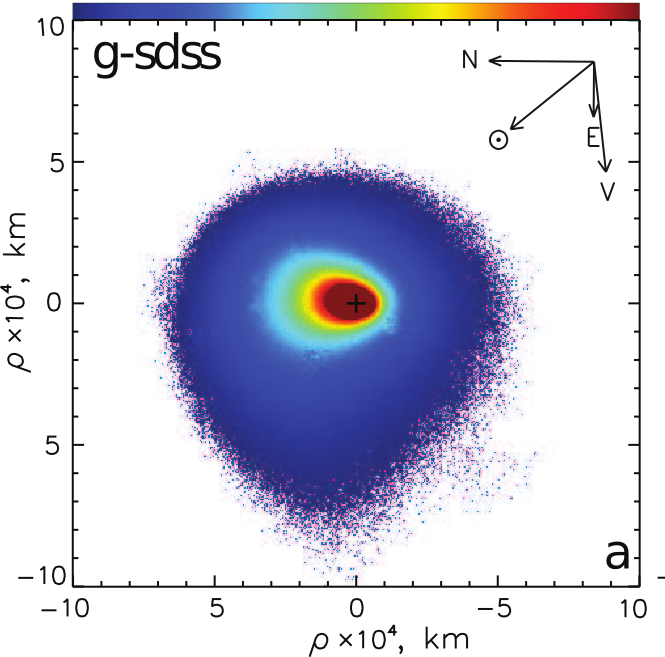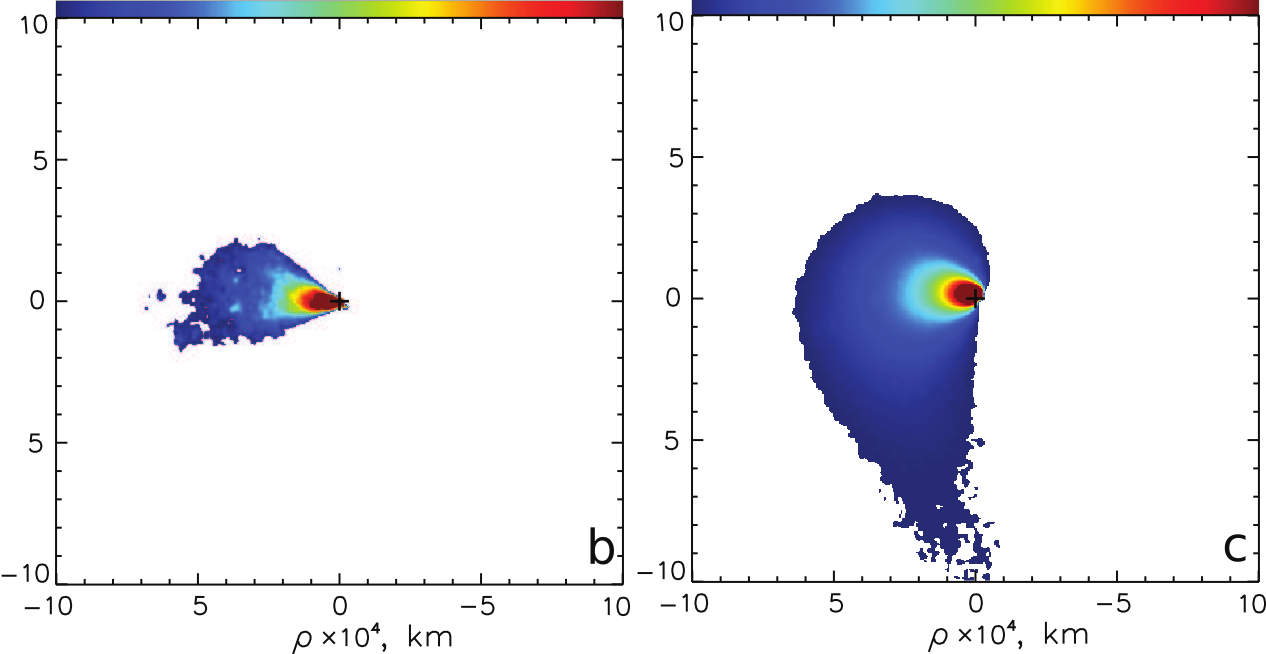Complex study of hyperbolic comet C/2013 X1 (PANSTARRS)
- 1Astronomical institute of Slovak academy of sciences, Tatranská Lomnica, Slovakia (oshubina@ta3.sk)
- 2Main astronomical observatory of National academy of sciences of Ukraine, Kyiv, Ukraine
- 3Astronomical observatory of Taras Shevchenko National University of Kyiv, Kyiv, Ukraine
Abstract
We present the results of complex (photometric, spectral, and polarimetric) observations of hyperbolic comet C/2013 X1 (PANSTARRS) obtained at 6-m telescope BTA on November 4, 2015. Color and dust productivity was estimated from photometrical and spectral data. Distribution maps of intencity and degree of the linear polarization were constructed. Analysis of morphology showed a non-uniform structure of the dust coma. Emission features of several molecules were detected in the cometary spectrum.
1. Introduction
New comets, coming from the Oort Cloud at their first passage close to the Sun, are particularly important because their matter is supposed to contain primordial material not differentiated by the Solar radiation. Comet C/2013 X1 (PANSTARRS) is a hyperbolic comet, that firstly came into the inner parts of the Solar system. It was discovered on December 4, 2013 by the Panoramic Survey Telescope and Rapid Response System (Pan-STARRS) 1 telescope on Mount Haleakala. C/2013 X1 reached a perihelion distance of 1.314278 AU on April 20, 2016. We present the results of preperihelion observations using broadband photometrical, long-slit spectral, and broadband polarimetric methods. Such complex analysis allows us to study more precisely the dust and gas components of the comet.
2. Observations
The observations of comet C/2013 X1 were carried out on November 4, 2015, before the perihelion passage when the heliocentric and geocentric distances of the comet were 2.66 au and 1.78 au, respectively, and the phase angle was 12.29°. The multimode focal reducer SCORPIO-2 [1, 2] attached to the prime focus of the 6-m Big Telescope Altazimuth (BTA) was used. The observations of the comet were conducted in the packet mode, which allowed us to make a sequence of exposures to obtain direct CCD images, spectra with a long-slit, and imaging linear polarimetry. We used the CCD chip E2V-42-90 with 2K × 2K square pixels of 16 µm corresponding to 0.18ʹʹ on the sky plane without binning.
Photometry and polarimetry of comet C/2013 X1 were performed through the g-sdss (the central wavelength λ0 and FWHM are λ4650/1300 Å) and Johnson-Cousins R (λ6400/1580 Å) broadband filters, respectively.
We derived spectra of the comet with a long-slit mask using the transparent grism VPHG1200@540 as a disperser in the spectroscopic mode of the SCORPIO-2. The slit of 6.1 arcmin × 1.0 arcsec was placed on the nucleus position in the sky and oriented along the velocity vector of the comet. The obtained spectra covered the wavelength range 3600–7070 Å.
3. Results
Photometry. We estimated the dust productivity using the Afρ parameter. It was about 1500 cm. The comet demonstrated typical red colour, based on V-R calculated value. To reveal the low-contrast structures in the dust coma, we constructed an intensity map of comet C/2013 X1 using digital filters (Fig. 1).


Figure 1: Intensity maps of comet C/2013 X1 (PANSARRS). (a) direct image of the comet; with using digital filters: (b) a rotational gradient method [4], and (c) division by 1/ρ profile [5].
Based on the distribution map of intencity, we derived the radial profiles of the surface brightness for observed structures to describe the dust brightness as a function of the distance from the optocenter. The profiles demonstrate slopes differed from the value -1, which corresponds to the case of a steady and isotropic emission of long-lived grains.
Polarimetry. We obtained the degree of linear polarization for comet C/2013 X1. It is distributed non-uniformly over the cometary coma. The value of linear polarization degree variates from -1.1% to -3.2%. It is clearly seen differences between the polarization of cometary structures. Changes in polarization degree are indicative of different properties of dust particles in various parts of the comet. We have also made profiles of the linear polarization of the comet in the direction with the jets structures and the quiet coma.
Spectroscopy. We analyzed a cometary spectrum in the wavelength region of 3800-7100 Å. Despite the heliocentric distance of 2.66 au, we detected significant gas emission lines in the spectrum. The strongest features belong to molecules of CN, C2, C3, and NH2.
Gas production ratios were calculated for all detected molecules using the Haser model [3]. Also, we estimated the gas contribution in wavelength regions corresponding to filters used for photometric and polarimetric studies. To compare with photometrical results we also computed a colour slope value based on the spectral data. The results from both methods are in good agreement.
Acknowledgments
The research is supported by the Slovak Academy of Sciences (grant Vega 2/0059/22). This work was supported by the Slovak Research and Development Agency under the Contract no. APVV-19-0072. Data analyzed in this work was obtained by V.L.Afanasiev.
References
[1] Afanasiev, V. L., & Moiseev, A. V. 2011, Balt. Astron., 20, 363
[2] Afanasiev, V. L., & Amirkhanyan, V. R. 2012, Astrophys. Bull., 67, 438
[3] Haser L. (1957) Bull. Soc. R. Sci. Liege, 43, pp. 740-750
[4] Larson, S. M., & Sekanina, Z. (1984), AJ, 89, 571
[5] Samarasinha, N. H., & Larson, S. M. (2014), Icarus, 239, 168
How to cite: Shubina, O. and Ivanova, O.: Complex study of hyperbolic comet C/2013 X1 (PANSTARRS), Europlanet Science Congress 2022, Granada, Spain, 18–23 Sep 2022, EPSC2022-216, https://doi.org/10.5194/epsc2022-216, 2022.

